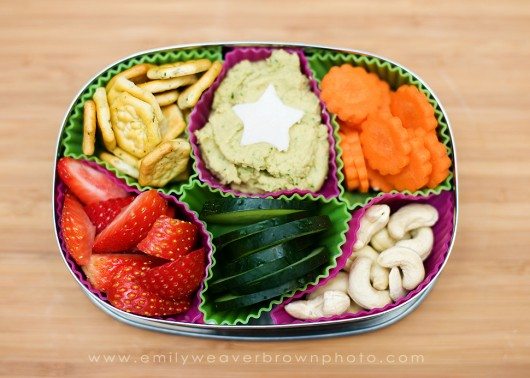There’s so much talk of what NOT to eat, that we sometimes forget to talk about what TO eat. How much we need to eat depends largely on:
- Age (calorie requirements go down with age)
- Sex (Males need more calories than females)
- Physical activity level (whether you’re sedentary, moderately active, or very active)
But what we need to eat to give our bodies essential nutrients is pretty much the same across the board (unless you have a chronic disease or food allergy). For more specific info about what you should be eating from each food group, based on your age, sex, and activity level check out USDA’s MyPlate.
If you’re looking for general guidelines, here are my recommendations:
- As many vegetables and fruits as you want, but at least 3-4 servings of vegetables and 2-3 servings of fruit
- Veggie serving = 1/2 cup chopped or pieces, 1 medium tomato or similar-sized whole veggie, 1 cup leafy greans, 1/4 cup veggie-based sauce, salsa, or soup
- Fruit serving = 1/2 cup chopped or sliced; 1 cup grapes or cherries or similar-sized fruit; 1 medium whole fruit like apple, peach, banana; 2-3 small fruits like apricots or small plums
- A serving of protein at every meal or snack
- Meals = 3 oz fish or lean meat, 1/2 cup tofu or soy product, 2 eggs
- Snacks = 1/4 cup nuts, 2 Tbsp nut butter, 1 oz reduced-fat cheese, 6 oz yogurt, 1 cup milk or plain soymilk, 1 egg, 1/2 cup cottage cheese
- About 3-4 servings of whole grain carbohydrates
- 1 piece whole wheat (or other 100% whole grain) bread
- 1/2 cup dry oats or 1/3 cup dry oat bran
- 3/4 cup whole grain cereal
- 1/2 cup cooked brown rice, quinoa, whole wheat couscous, pasta
- One source of dietary fat at each meal or snack (keep in mind that the fat may be naturally occurring in whatever food you’re eating, like cheese, nuts, yogurt, etc)
- Meals = 1 Tbsp oil; 1 Tbsp butter or mayonnaise; 1 oz cheese; having a fattier meat like steak, salmon, or bone-in chicken
- Snacks = 1 oz cheese; 1/4 cup nuts; 1 Tbsp nut butter; 1 “bar” like Kind, Luna, or Corazonas snack bar
- A serving of legumes (beans, lentils, etc) a few times a week
- 1/2 cup beans or lentils
- If you’re vegetarian, you’ll need more like one serving legumes everyday
Keep in mind that some foods, like nuts, fatty meats and fish, soybeans, cheese, whole milk products — fall into more than one category (protein + fat) so if you choose these, count them in both places and then choose leaner options at your next meal or snack. Most mixed foods that you eat fall into more than one of these categories too, so you’ll have to think about what ingredients are present in a recipe or meal to see which groups you’re eating.
Everything else — packaged snack foods, refined carbohydrates, sweets, baked goods, processed or prepared foods, alcoholic beverages — should be eaten only occasionally. Aim for one “splurge” per day. Plan your splurge ahead of time (for example, think about if you’ll want dessert after dinner, if you’re going out for cocktail with friends, if you’ll be grazing on bread & cheese at a dinner party, etc) so that one splurge doesn’t turn into 2 or 3 or more.







6 Comments
shelley hudson
July 17, 2011 at 12:15 amThis information is so concise and eater-friendly!
Millie
July 20, 2011 at 3:47 pmI agree! Love this information!
Kristin
December 5, 2011 at 12:51 amAll the fruit in your picture looks amazing!! I would love to eat that everyday. I wish rainer cherries, strawberries, and peaches were in season year-round!
Amelia
December 7, 2011 at 8:35 amI know, if only cherry season were a little longer!